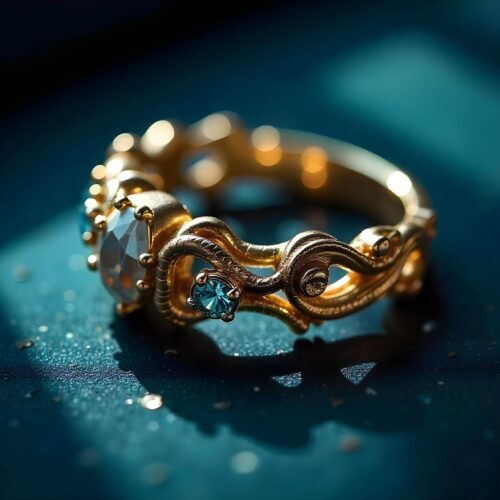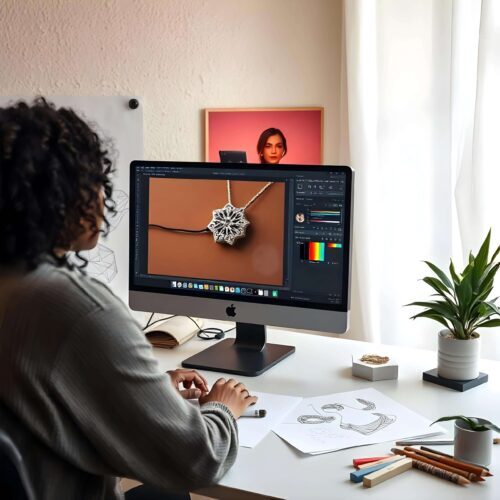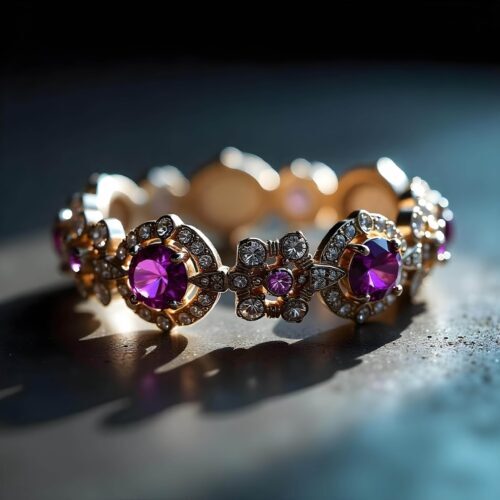Building a versatile summer dresses wardrobe is the key to feeling confident and stylish all…

Key Tips for Jewelry Image Retouching You Should Know
Jewelry image retouching is a crucial step in showcasing beautiful and high-quality jewelry photography. With the rise of e-commerce and social media, jewelry brands need to present their products in the best possible light to attract customers and stand out from the competition. In this article, we will explore the key tips and techniques for jewelry image retouching, from essential tools to advanced techniques, to help you achieve stunning results.
Mastering Jewelry Image Retouching
Retouching jewelry images requires a combination of technical skills, creativity, and attention to detail. To get started, it’s essential to have a good understanding of the basics of image editing software such as Adobe Photoshop. Familiarize yourself with the tools and panels, and practice editing images to develop your skills. Jewelry image retouching requires a gentle touch, as over-processing can lead to unnatural-looking results.
 Another crucial aspect of jewelry image retouching is understanding the different types of jewelry and their unique characteristics. For example, delicate pieces require more care and attention to detail, while bold and chunky pieces can withstand more aggressive retouching. Knowing the type of jewelry, you are working with will help you tailor your approach to achieve the best results.
Another crucial aspect of jewelry image retouching is understanding the different types of jewelry and their unique characteristics. For example, delicate pieces require more care and attention to detail, while bold and chunky pieces can withstand more aggressive retouching. Knowing the type of jewelry, you are working with will help you tailor your approach to achieve the best results.
Essential Retouching Tools
When it comes to jewelry image retouching, the right tools can make all the difference. A good camera and lens are essential for capturing high-quality images, but retouching software is also crucial. Adobe Photoshop is a popular choice among image retouches, and its advanced features and tools make it an ideal choice for jewelry image retouching. Other essential tools include the Clone Stamp, Healing Brush, and Spot Healing Brush, which allow you to remove blemishes, imperfections, and scratches.
 In addition to retouching software, a good image editing workflow is also essential. This includes setting up layers, using color management, and saving files in the right format. A well-organized workflow will help you stay focused and ensure that your images look their best. Finally, a good pair of editing monitors and a comfortable editing space can make a big difference in your productivity and overall experience.
In addition to retouching software, a good image editing workflow is also essential. This includes setting up layers, using color management, and saving files in the right format. A well-organized workflow will help you stay focused and ensure that your images look their best. Finally, a good pair of editing monitors and a comfortable editing space can make a big difference in your productivity and overall experience.
Jewelry Image Editing Key Tips
Jewelry image retouching is all about the details. When editing images, pay attention to the smallest details, such as scratches, dust, and fingerprints. These imperfections can be easily removed using the Clone Stamp or Healing Brush, and a gentle touch is essential to maintain the original texture and appearance of the jewelry. Another important aspect of jewelry image retouching is adjusting the exposure and contrasting to make the jewelry stand out. This can be achieved by using the Curves tool or the Levels tool in Adobe Photoshop.
 When editing jewelry images, it’s also essential to work in small sections and zoom in on specific areas of the image. This will help you achieve more precise results and avoid over-processing the image. Finally, use the History Brush to make non-destructive edits and maintain the original image, allowing you to easily revert to previous versions if needed.
When editing jewelry images, it’s also essential to work in small sections and zoom in on specific areas of the image. This will help you achieve more precise results and avoid over-processing the image. Finally, use the History Brush to make non-destructive edits and maintain the original image, allowing you to easily revert to previous versions if needed.
How to Clean Up Jewelry Images
Cleaning up jewelry images requires a gentle touch. When removing imperfections, use the Clone Stamp or Healing Brush to blend the surrounding area with the defect, rather than using the Eraser tool, which can leave harsh edges. It’s also essential to work in small sections and blend the edges carefully to maintain the original texture and appearance of the jewelry.
 Another important aspect of cleaning up jewelry images is removing dust and debris. Use the Spot Healing Brush or the Clone Stamp to gently remove these imperfections, and avoid using the Eraser tool, which can spread the dust or debris to other areas of the image. Finally, use the Dust and Scratches filter in Adobe Photoshop to remove small imperfections and add a touch of realism to the image.
Another important aspect of cleaning up jewelry images is removing dust and debris. Use the Spot Healing Brush or the Clone Stamp to gently remove these imperfections, and avoid using the Eraser tool, which can spread the dust or debris to other areas of the image. Finally, use the Dust and Scratches filter in Adobe Photoshop to remove small imperfections and add a touch of realism to the image.
Color Correction Techniques
Color correction is a crucial aspect of jewelry image retouching. Jewelry can appear dull or lifeless if the colors are not accurately represented. To bring out the sparkle, use the Levels tool or the Curves tool in Adobe Photoshop to adjust the brightness and contrast of the image. You can also use the Color Balance tool to adjust the color temperature and make the jewelry appear more vibrant.
 Another important aspect of color correction is removing unwanted color casts. Use the Color Gradient tool or the Selective Color tool in Adobe Photoshop to remove color casts and add a touch of realism to the image. Finally, use the Hue/Saturation tool to adjust the color saturation and make the jewelry appear more vibrant and lifelike.
Another important aspect of color correction is removing unwanted color casts. Use the Color Gradient tool or the Selective Color tool in Adobe Photoshop to remove color casts and add a touch of realism to the image. Finally, use the Hue/Saturation tool to adjust the color saturation and make the jewelry appear more vibrant and lifelike.
Advanced Retouching Techniques for Jewelry
Advanced retouching techniques can take your jewelry image retouching to the next level. One such technique is using the Content-Aware Fill tool in Adobe Photoshop to remove large areas of imperfections. This tool allows you to fill in large areas with a seamless blend, making it ideal for removing scratches or blemishes.
 Another advanced technique is using the Perspective Warp tool in Adobe Photoshop to adjust the perspective of the image. This tool allows you to manipulate the image by adjusting the perspective, making it ideal for jewelry images with complex shapes or angles. Finally, use the Puppet Warp tool to adjust the shape and form of the jewelry, allowing you to create stunning and realistic results.
Another advanced technique is using the Perspective Warp tool in Adobe Photoshop to adjust the perspective of the image. This tool allows you to manipulate the image by adjusting the perspective, making it ideal for jewelry images with complex shapes or angles. Finally, use the Puppet Warp tool to adjust the shape and form of the jewelry, allowing you to create stunning and realistic results.
How to Remove Scratches
Removing scratches from jewelry images requires a gentle touch and a good understanding of the tools and techniques used in image retouching. Use the Clone Stamp or Healing Brush to remove small scratches, and avoid using the Eraser tool, which can leave harsh edges.
 Another important aspect of removing scratches is working in small sections and blending the edges carefully to maintain the original texture and appearance of the jewelry. Finally, use the Dust and Scratches filter in Adobe Photoshop to remove small imperfections and add a touch of realism to the image.
Another important aspect of removing scratches is working in small sections and blending the edges carefully to maintain the original texture and appearance of the jewelry. Finally, use the Dust and Scratches filter in Adobe Photoshop to remove small imperfections and add a touch of realism to the image.
Jewelry Image Retouching Strategies
Jewelry image retouching is all about transforming flawed images into flawless ones. One strategy is to work in small sections, focusing on one area at a time, and using a combination of tools and techniques to achieve the desired result. Another strategy is to use the History Brush to make non-destructive edits and maintain the original image, allowing you to easily revert back to previous versions if needed.
 Another important aspect of jewelry image retouching is having a clear understanding of the type of jewelry you are working with. For example, delicate pieces require more care and attention to detail, while bold and chunky pieces can withstand more aggressive retouching. Knowing the type of jewelry, you are working with will help you tailor your approach to achieve the best results.
Another important aspect of jewelry image retouching is having a clear understanding of the type of jewelry you are working with. For example, delicate pieces require more care and attention to detail, while bold and chunky pieces can withstand more aggressive retouching. Knowing the type of jewelry, you are working with will help you tailor your approach to achieve the best results.
Enhancing Jewelry Images with Light
 Enhancing jewelry images with light is a crucial aspect of jewelry image retouching. Use the Dodge tool or the Burn tool in Adobe Photoshop to add highlights and shadows to the image, making it appear more three-dimensional and realistic. Another important aspect of adding light to jewelry images is removing harsh shadows and highlights. Use the Shadows/Highlights tool or the Curves tool to adjust the contrast and make the jewelry appear more natural. Use the Glamour Glow filter in Adobe Photoshop to add a touch of glamour to the image. This filter allows you to add a subtle glow to the image, making it appear more vibrant and lifelike.
Enhancing jewelry images with light is a crucial aspect of jewelry image retouching. Use the Dodge tool or the Burn tool in Adobe Photoshop to add highlights and shadows to the image, making it appear more three-dimensional and realistic. Another important aspect of adding light to jewelry images is removing harsh shadows and highlights. Use the Shadows/Highlights tool or the Curves tool to adjust the contrast and make the jewelry appear more natural. Use the Glamour Glow filter in Adobe Photoshop to add a touch of glamour to the image. This filter allows you to add a subtle glow to the image, making it appear more vibrant and lifelike.
Final Tips for Jewelry Image Retouching Success
To achieve successful jewelry image retouching results, it’s essential to stay focused and organized throughout the process. Use good image editing workflow, and work in small sections to maintain precision and control. Also, use the right tools and techniques for the type of jewelry you are working with, and don’t be afraid to experiment and try new things.
Another important aspect of jewelry image retouching success is having a clear understanding of the brand’s visual identity and guidelines. This will help you tailor your approach to achieve the desired results and ensure that the images meet the brand’s standards. Finally, stay up to date with the latest trends and techniques in image retouching, and continuously practice and improve your skills to achieve the best results.
Jewelry image retouching is a crucial step in showcasing beautiful and high-quality jewelry photography. By mastering the key tips and techniques outlined in this article, you can achieve stunning results and help your jewelry brand stand out from the competition. Remember to stay focused, organized, and creative throughout the process, and always keep in mind the brand’s visual identity and guidelines. With practice and patience, you can master the art of jewelry image retouching and take your jewelry photography to the next level.
Conclusion
In conclusion, jewelry image retouching is key to showcasing the beauty and quality of pieces in the crowded e-commerce and social media space. By mastering the essential techniques and tools, you can create polished images that really grab attention. Focus on the details, follow a structured workflow, and adapt your approach to each unique piece. Keep the brand’s visual identity in mind and continually sharpen your skills to achieve eye-catching results. With a bit of creativity and dedication, you can turn your jewelry images into captivating visual stories that connect with your audience.



